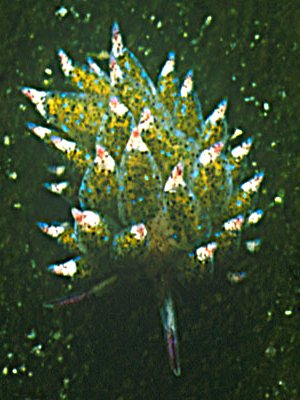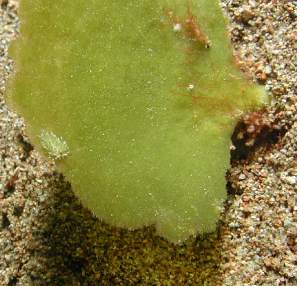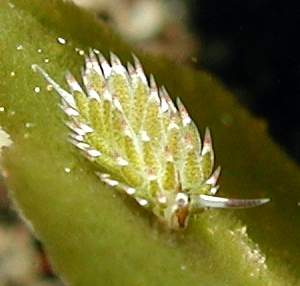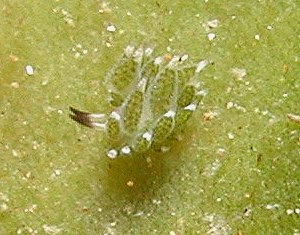

Costasiella sp. 3
Order: SACOGLOSSA
Superfamily: LIMAPONTIOIDEA
Family: Costasiellidae
PHOTO
Upper: Lembeh, Sulawesi, Indonesia. On green algae at 10 meters. Less than 5mm in length. December 2002. Photo: Takako Uno
Lower: Negros Oriental Island, Lipayo (near Dumaguete), Philippines, depth 8-11m, March 2003. Photo: Erwin Koehler.
It is not possible to be confidently identify animals from photos alone. However from the range of photos now available it seems that this species of Costasiella shows some variation in the colour of the cerata. The head has a broad brownish band from the rhinophores to the mouth, and their is a second brown patch from the rhinophores back towards the pericardium. The lower half of the rhinophores are white and the upper half is black, although it seems there can be a white or translucent tip in some specimens. The cerata are transparent, with the green speckled contents showing through the body wall. There is an opaque white cap to the digestive gland just below the translucent tip. In some animals there can be a red or pickish spots on the dorsal side of the cerata just below the tip. In one photo, opalescent blue patches can also be seen on the ceratal wall.
I have included here photos which were previously labelled Costasiella cf. kuroshimae. As discussed earlier another species has been identified as C. kuroshimae. It is unfortunate that most species of Costasiella have been described from one or very few specimens. Without a knowledge of their colour variation it is difficult to identify specimens which don't exactly match the original description.
Authorship detailsRudman, W.B., 2003 (April 2) Costasiella sp. 3 [In] Sea Slug Forum. Australian Museum, Sydney. Available from http://www.seaslugforum.net/find/costsp3
Related messages
Costasiella sp. 3 from Bali
August 16, 2009
From: Douglas Hansen

Concerning message #21196:
Bill,
Attached are some photos of a sea slug we found in Puri Jati, Bali. My best guess is that they are a species of Stiliger, but I am not sure. They were quite common on the algae in that bay. They were quite small (4-8 mm), and I apologize for the poor quality of the photos. Even with a 50 mm macro lens they were difficult to photograph.
Locality: Puri Jati, 7 meters, Bali, Indonesia, Pacific Ocean, May 20, 2009, on algae in black sand bay. Length: 4-8 mm. Photographer: Douglas Hansen.
Thank you.
Doug Hansen.
mhel0323@sbcglobal.net



Dear Doug,
This does look quite like Stiliger or one of the other sacoglossans which look like aeolids. It belongs to an interesting genus of sacoglossans which are most easily identified by having their eyes very close together in the middle of the head. I have included two close-ups from your photos which show this. The genus is Costasiella, and this species is what I am calling Costasiella sp. 3.
One other characteristic is that species of Costasiellaappear to specialise on living on, and eating the fan-shaped green alga Avrainvillea. It would be interesting to know if this is the type of algae your animals were found on
Best wishes,
Bill Rudman
Re: Costasiella sp. from Ratnagiri, India
May 19, 2009
From: Vishal Bhave
Concerning message #22422:
Dear Bill,
It was found on Sargassum but when I kept it in Aquaria (for about a month and now I have a single specimen preserved). in my daily observation, I had seen it on the alga Avrainvillea spp. I wasn't able to include this in previous message as the alga (Avrainvillea spp.) was not familliar to me.
Locality: Mandavi, Ratnagiri, Maharashtra, India, Arabian sea
Vishal Bhave
vishalbhave@gmail.com
Bhave, V.J., 2009 (May 19) Re: Costasiella sp. from Ratnagiri, India. [Message in] Sea Slug Forum. Australian Museum, Sydney. Available from http://www.seaslugforum.net/find/22475Dear Vishal,
Thanks for the feedback.
Best wishes,
Bill Rudman
Costasiella sp. from Ratnagiri, India
May 18, 2009
From: Vishal Bhave

This unidentified aeolid was found in rock pool; on an alga (Sargassum spp.). It is still alive in my tank.
Locality: Rocky patch, Mandavi, Ratnagiri, 0.5 foot, Maharashtra, India, Arabian sea, 14 February 2009, Intertidal, beneath rocks in rockpool. Length: 8 mm. Photographer: Vishal Bhave.
Vishal Bhave
vishalbhave@gmail.com
Bhave, V.J., 2009 (May 18) Costasiella sp. from Ratnagiri, India. [Message in] Sea Slug Forum. Australian Museum, Sydney. Available from http://www.seaslugforum.net/find/22422
Dear Vishal,
Although the cerata remind us of an aeolid, this is in fact a herbivorous sacoglossan,Costasiella sp. 3. One clue to its identity is the position of its black eyes - very close together in the dorsal midline between the head tentacles. Species of Costasiella have usually been found associated with species of the green algal genus Avrainvillea
Best wishes,
Bill Rudman
Costasiella sp. 3 from Bali
October 28, 2008
From: Supapong Areeprasertkul

I have no idea in which group this stuff would be classified. I tried looking in the book of Helmut Debelius and found no clue.
Locality: Bali, 5 - 8 metres, Puri Jati, Bali, Indonesia, Bali, 16 August 2007, Sandy bottom. Length: 1 cm. Photographer: Supasate Areeprasertkul.
Thanks
Supasate Areeprasertkul
zybersup@gmail.com
Supasate, A., 2008 (Oct 28) Costasiella sp. 3 from Bali. [Message in] Sea Slug Forum. Australian Museum, Sydney. Available from http://www.seaslugforum.net/find/20529
Dear Art,
When you see aeolid-like sea slugs on this type of green algae then they are most likely to be a species of the sacoglossan genus Costasiella. The algae, with a post like 'stalk' and a flattened plate-like 'leaf' is likely to be a species of the green algal genus Avrainvillea.
I am pretty sure your animal is one I am calling Costasiella sp. 3. If you look carefully you can see a number of their spiral egg strings stuck to the algae, including one along the edge of the algae just behind the Costasiella.
Best wishes,
Bill Rudman
Costasiella sp. from Indonesia
October 28, 2008
From: Ann Clear

Hi Bill,
I took these photos of these tiny nudibranchs, who I found underneath a thick green leaf on a muck dive. They were very small and there was quite a current, hence the not so good photos. Dave Behrens kindly identified them for me as Costasiella kuroshimae, but I thought you might like to see them as there are not many of them on the forum and none from this area.
Locality: Lembeh Straits dive site retack larry, 10 metres, Indonesia, Molucca sea, 13 march 2007, muck dive . Length: 6 mm. Photographer: Ann Clear.
Best regards
Ann Clear
ann.clear@btinternet.com
Clear, A, 2008 (Oct 28) Costasiella sp. from Indonesia. [Message in] Sea Slug Forum. Australian Museum, Sydney. Available from http://www.seaslugforum.net/find/20222
Dear Ann,
This is a species of Costasiella, but unless they show an incredible amount of colour variation I don't think this is C. kuroshimae. I am calling this one Costasiella sp. 3 on the Forum because I don't think it has a name at present.
Best wishes,
Bill Rudman
Costasiella sp. 3 from the Philippines
October 10, 2007
From: Jeffrey de Guzman

Hello
I observed this Placida dendritica on a green leafy sea plant. Can you confirm if this is that species?
Locality: Anilao, 15 Meters, Philippines, Philippines, 05 October 2007, Sandy - muck diving. Length: 0.8 cm. Photographer: Jeffrey C. de Guzman.
Jeffrey C. de Guzman
jeffdeguzman@gmail.com
de Guzman, J. C., 2007 (Oct 10) Costasiella sp. 3 from the Philippines. [Message in] Sea Slug Forum. Australian Museum, Sydney. Available from http://www.seaslugforum.net/find/20908
Dear Jeff,
This is a sacoglossan, but not a species of Placida. In the lower photo you can see that the two large back eyes are close together between the rhinophores. This is only found in the genus Costasiella, and you animal is one we are calling Costasiella sp. 3 at present.
Best wishes,
Bill Rudman
Costasiella sp. 3 from New Caledonia
September 21, 2007
From: Jean-François Hervé


Dear Bill,
Could you help me to ID the two species of little limapontiids which we can see on an algae in this and a second message [#20688]. Maybe this is Placida dendritica and the other Costasiella ocellifera, or the reverse?
Locality: Noumea, Ouemo Beach, 10 m, New Caledonia, Pacific ocean, July and January 2006, Algae. Length: 5 mm. Photographer: Jean-François Hervé.
Best wishes.
Jean-François Hervé.
jfherve@free.fr
Hervé, J.-F., 2007 (Sep 21) Costasiella sp. 3 from New Caledonia. [Message in] Sea Slug Forum. Australian Museum, Sydney. Available from http://www.seaslugforum.net/find/20752
Dear Jean-François,
This is what I am calling Costasiella sp. 3. Species of Costasiella seem to feed on green algae of the genus Avrainvillea, which could well be the one your animals are on. One easy way to recognise species of Costasiella are their eyes. No other group of sacoglossans have their eyes close together in the middle of the head like this.
I found this is species in Noumea in 1988 on the green algae Avrainvillea nigricans.
Best wishes,
Bill Rudman
Costasiella sp. 3? from Bali
November 30, 2006
From: Linda Ianniello

Dear Bill
I think this is Costasiella sp. 3? I found several, all on the same type of algae, very small and tough to photograph. Here are two shots, one with what appears to be two color variations.
Locality: Puri Jati, Bali, 20 feet, Indonesia, 2 September 2006, Muck. Length: very small. Photographer: Linda Ianniello.
Regards,
Linda I.
lindai1@bellsouth.net



Dear Linda,
This species seems to be quite variable in colour, but I suspect the difference in 'greenness' - if there is such word - may be to do with how much algal material is in the digestive gland branches in the cerata.
Best wishes,
Bill Rudman
Costasiella sp. 3 from Bali
March 4, 2005
From: Ian Dunsmore

Dear Bill,
Here is an unusual one and I see there are not too many postings of the species. This looks to be identical with Stiliger aureomarginatus however the tips of the cerata are most definitely a pinkish/purple colour and not the distinctive bright orange/yellow as with your other listings. Is this the same species and is the colour variant due to feeding habits on the host algae? It's so small it was a tough one to photograph - I was getting dizzy and going crossed eyed trying to focus and get him in the viewfinder, all whilst fighting a swell.
Locality: Puri Jati - Bali, Indonesia, Indian Ocean. Depth: 5 metres. Length: 5mm. 07 February 2005. Volcanic sand slope - shore dive. Photographer: Ian Dunsmore
Many thanks,
Ian.
scubajock@moylan-diving.com


Dear Ian,
You've done a good job firstly finding this animal, and secondly photographing it. It is indeed a sacoglossan, but although it looks very like a species of Stiliger, it is a species of Costasiella, an unnamed species I am calling Costasiella sp. 3 on the Forum. One sure way to identify a species of Costasiella is to look at its eyes, which are very close together - almost touching each other. Another clue in this case is the strange green algae it is on. Quite a few species of Costasiella specialise in feeding on species of the green alga Avrainvillea, which has a broad fan-like 'leaf' and a solid cylindrical stalk, anchoring it in the sediment.
Best wishes,
Bill Rudman
Costasiella sp 3 from Lizard Id, Queensland
January 9, 2004
From: Nils Anthes

Dear Bill,
This Aeolid was found on algae in 16m depths on sandy bottoms, Lizard Island, QLD Australia (20 December 2003). Body length about 9mm. Have you got any idea what it is?
Kind regards
Nils
anthes@uni-muenster.de
Anthes, N., 2004 (Jan 9) Costasiella sp 3 from Lizard Id, Queensland. [Message in] Sea Slug Forum. Australian Museum, Sydney. Available from http://www.seaslugforum.net/find/11834Dear Nils,
This is a sacoglossan rather than an aeolid, and belongs to the genus Costasiella which can be distinguished externally by the position of the eyes, close together in the dorsal midline. This species is rather widespread and is on the Forum as Costasiella sp 3.
Best wishes
Bill Rudman
More Costasiella cf. kuroshimae from Philippines
April 2, 2003
From: Erwin Koehler

Dear Bill,
Last week (March 17) I returned from my recent trip to the Philippines. Here are 3 more pictures of Costasiella cf. kuroshimae. One showing 3 specimens (4, 4, 1mm) and their egg-mass, one showing the algae they feed on and the last one is a close-up (higher magnification with my equipment is not possible). I've collected 6 specimens and their egg-mass and sent it to Lucas Cervera. Hopefully he can tell us more.
All shots were done at Negros Oriental Island, Lipayo (close to Dumaguete), divesite "Dauin", depth 8-11m, March 2003.
Erwin
Erwin@medslugs.de


Thanks Erwin,
The algae is almost certainly a species of Avrainvillea, which Kathe Jensen says is the normal food plant of this genus. The biggest problem with identifying species of Costasiella is not so much difficulties with their anatomy, but difficulties with previous descriptions. It is just not possible to know how variable a species is when it is described from a single specimen, and that description gives a minimal amount of information on the colour, and a stylised black & white drawing. These photos, and your earlier ones, which I labelled Costasiella cf. kuroshimae, suggest that this species is quite variable in colour, sometimes having a reddish spot below the ceratal tip, and in some photos at least showing iridescent blue spots on the cerata. It also seems the upper half of the rhinophores are black, but can sometimes have a white tip. The head also has a broad brownish band from the rhinophores to the mouth and a second patch from the rhinophores back towards the pericardium.
I guess we may as well accept that the animal we are now identifying as Costasiella kuroshimae is correctly identified. I suspect there is no way of ever being sure. To prevent confusion it is probably best to amalgamate the Costasiella cf. kuroshimae messages and the Costasiella sp. 3 messages and call them all
Best wishes,
Bill Rudman
Re: Costasiella from Indonesia
March 27, 2003
From: Erwin Koehler
Hi Bill,
I think Takako's animal is the same as my one which you labelled Costasiella cf. kuroshimae
Cheers Erwin
Erwin@medslugs.de
Dear Erwin,
I guess its possible they are the same but as I said in my earlier comment, many of these species have been named from one or very few specimens so we have no idea how variable they are in colour. While the absence of a red spot and scattered blue spots on the cerata of your animal may be a variation, I would find it less likely that the difference in rhinophore colour is just a variation. In Takako's animal there is a black line along the upper half of the dorsal side of the rhinophore, while in your animal the whole of the upper half of each rhinophore is black.
Best wishes,
Bill Rudman
Re: Costasiella from Indonesia
March 17, 2003
From: Kathe R. Jensen
Dear Takako and Bill,
Takako's animal is indeed a species of Costasiella, and I am fairly certain that it is the same species I collected in Lombok, Indonesia some years ago. The seaweed that it is on is a species of Avrainvillea, which is the food and substrate of almost all species of Costasiella.
Best wishes,
Kathe
krjensen@zmuc.ku.dk
Thanks Kathe,
Bill Rudman
Costasiella from Indonesia
March 15, 2003
From: Takako Uno


Dear Dr. Rudman,
This sea slug is also from Lembeh, Sulawesi, Indonesia on Dec 2002 trip. It was on some kind of seagrass at 10 meters. The little nudi was less than 5mm in length. Photo: Takako Uno
Can you tell me which kind is it? Is it Stiliger or Costasiella?
Warmest thanks,
Takako
divetoto@hotmail.com
Uno, T., 2003 (Mar 15) Costasiella from Indonesia. [Message in] Sea Slug Forum. Australian Museum, Sydney. Available from http://www.seaslugforum.net/find/9199Dear Takako,
The best way to separate Costasiella from other sacoglossans with cerata is to look at their eyes, which in Costasiella are very close together. However I can't see them in your photo. However from the general shape of the body I am pretty sure your animal is a species of Costasiella. I have checked the known species of the genus and cannot find a description that fits your species. One problem is that many of the species have been described from one or very few specimens, so without any knowledge of the colour variation in each species it is impossible to know whether your photo represents a new species or a colour variation of a named species. At present I will call it Costasiella sp. 3.
Best wishes,
Bill Rudman
Costasiella from the Philippines
May 15, 2002
From: Erwin Köhler

Dear Bill,
Concerning the possible Costasiella. Here is a shot by Klaus Stark [email K.Stark@t-online.de]) showing both animals together. I hope you can see the eyes good enough.
Erwin
Erwin@medslugs.de
Köhler, E., 2002 (May 15) Costasiella from the Philippines. [Message in] Sea Slug Forum. Australian Museum, Sydney. Available from http://www.seaslugforum.net/find/6940Note: Moved to Costasiella sp. 3. See relevant message. - 2 April 2003
Thanks Erwin,
Yes the eyes are clearly those of a Costasiella. It is possibly Costasiella kuroshimae Ichikawa 1993 but unfortunately the description is not detailed enough to be sure. We have no idea of how variable species of Costasiella are in colour so it is impossible to know whether differences between this animal and the original description are intra-specific or inter-specific.
Costasiella kuroshimae was described as having a white head with dark marks in the midline and a dark streak across the head just in front of the rhinophores. Also a dark grey-black streak behind the eyes in dorsal midline was described. The tips of the white rhinophores were reported to be black, but in Ichikawa's drawing the black did not extend halfway down as in these photos. The cerata were described as 'generally green with white tips'. Ichikawa described a number of species of Costasiella in a similar brief fashion. Of all the species described, this is the only one that come near to these photos.
• Ichikawa, M. (1993) Saccoglossa (Opisthobranchia) from the Ryukyu Islands. Publications of the Seto Marine Biological Laboratory, 36: 119-139.
Best wishes,
Bill Rudman
Costasiella from the Philippines
May 9, 2002
From: Erwin Köhler


Dear Bill,
Here are the next shots from the Philippines,
Negros Oriental Island, Lipayo, divesite
"Dauin".
Sizes: Upper: 4mm, Lower: 3mm
Depth: 7m
08.March 2002.
Erwin
Erwin@medslugs.de
Köhler, E., 2002 (May 9) Costasiella from the Philippines. [Message in] Sea Slug Forum. Australian Museum, Sydney. Available from http://www.seaslugforum.net/find/6637Note: Moved to Costasiella sp. 3. See relevant message. - 2 April 2003
Dear Erwin,
I am pretty sure this is a species of Costasiella but I can't see the position of the eyes in your photos to be sure. If it is that genus there are a couple of species described from Japan which are quite close but not exactly the same.
• Costasiella paweli was described with black rhinophores, head and tail white, cerata green with white tips and spotted with black specks.
• C. kuroshimae has white rhinophores with white tips and the cerata are generally green with white tips.
Both species were described by Ichikawa (1993) from a few specimens. At present we do not know how variable in colour species of Costasiella but at present I can't really identify your animals with any named species.
• Ichikawa, M. (1993) Saccoglossa (Opisthobranchia) from the Ryukyu Islands. Publications of the Seto Marine Biological Laboratory, 36: 119-139.
Best wishes,
Bill Rudman
